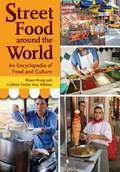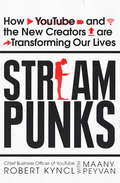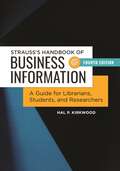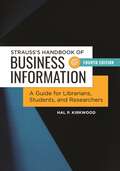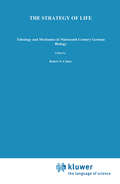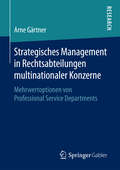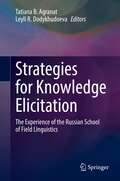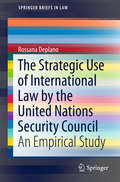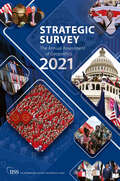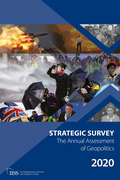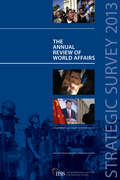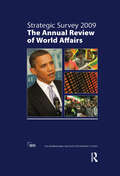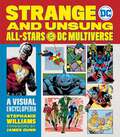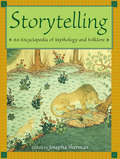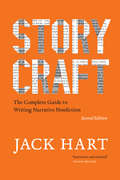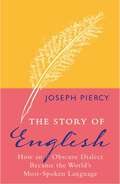- Table View
- List View
Street Food around the World: An Encyclopedia of Food and Culture
by Bruce Kraig Colleen Taylor SenIn this encyclopedia, two experienced world travelers and numerous contributors provide a fascinating worldwide survey of street foods and recipes to document the importance of casual cuisine to every culture, covering everything from dumplings to hot dogs and kebabs to tacos.Street foods run deep throughout human history and show the movements of peoples and their foods across the globe. For example, mandoo, manti, momo, and baozi: all of these types of dumplings originated in Central Asia and spread across the Old World beginning in the 12th century. This encyclopedia surveys common street foods in about 100 countries and regions of the world, clearly depicting how "fast foods of the common people" fit into a country or a region's environments, cultural history, and economy. The entries provide engaging information about specific foods as well as coverage of vendor and food stall culture and issues. An appendix of recipes allows for hands-on learning and provides opportunities for readers to taste international street foods at home.
Street Food around the World: An Encyclopedia of Food and Culture
by Bruce Kraig Colleen Taylor Sen Fuad Ahmad Chitradeepa Anatharam Paula Arvela Rosemary Barron Manya Brachear Cynthia Clampitt Charlotte De Backer Monica Eng Clothilde Façon Rachel Finn Ove Fosså Olívia Fraga Shahrzad Ghorashian David Hammond Anissa Helou Richard Hosking Sharon Hudgins Phil Iddison Katrine Klinken Robert Launay Whitney Lingle Máirtín Mac Con Iomaire Ian Martin Laura Mason Marcela Mazzei Adrian Miller Katerina Nussdorfer Sarahlynn Pablo Gaitri Pagrach-Chandra Jorge Pérez Birgit Ricquier Nanna Rögnvaldardóttir Helen Saberi Heba Saleh María José Sevilla Mike Sula Richard Tan Aylin Öney Tan Viktorija Todorovska Karin Vaneker Paul Van Reyk Susan WeingartenIn this encyclopedia, two experienced world travelers and numerous contributors provide a fascinating worldwide survey of street foods and recipes to document the importance of casual cuisine to every culture, covering everything from dumplings to hot dogs and kebabs to tacos.Street foods run deep throughout human history and show the movements of peoples and their foods across the globe. For example, mandoo, manti, momo, and baozi: all of these types of dumplings originated in Central Asia and spread across the Old World beginning in the 12th century. This encyclopedia surveys common street foods in about 100 countries and regions of the world, clearly depicting how "fast foods of the common people" fit into a country or a region's environments, cultural history, and economy. The entries provide engaging information about specific foods as well as coverage of vendor and food stall culture and issues. An appendix of recipes allows for hands-on learning and provides opportunities for readers to taste international street foods at home.
Streampunks: How YouTube and the New Creators are Transforming Our Lives
by Robert Kyncl Maany Peyvan***Axiom Business Book Award Winner!***Something massive is shifting in the world of entertainment.Across the planet, humans spend more of their free time watching video than doing anything else. But increasingly it’s not TV they're watching, but online video. In 2016, Swedish vlogger PewDiePie made a record $15 million from his YouTube videos, beating Hollywood A-listers like Harrison Ford, Julia Roberts and Amy Adams. Something massive is shifting in the world of entertainment. Since its founding in 2005, YouTube has become the first and only truly global media platform, with over a billion users worldwide. It has changed the media industry as profoundly as the development of radio, film and television. In Streampunks, YouTube’s Chief Business Officer Robert Kyncl gets to the heart of this creative revolution through behind-the-scenes stories of its biggest stars – YouTubers like Tyler Oakley, Lilly Singh, and Casey Neistat—and the dealmakers brokering the future of media, like Scooter Braun, who scouted 12-year old Justin Bieber on YouTube, and Vice media mogul Shane Smith who used the platform to turn young people onto news and current affairs.By giving anyone with a smartphone their own TV channel, YouTube is fuelling a new creative boom. Not only is it generating the new faces of entertainment, but also changing how students are taught, how social issues are discussed and how small businesses advertise and develop.Streampunks is the definitive book on the modern pop-culture juggernaut Youtube, the platform remaking the face of entertainment.
The Stray Shopping Carts of Eastern North America: A Guide to Field Identification
by Julian MontagueA taxonomy we didn’t know we needed for identifying and cataloging stray shopping carts by artist and photographer Julian Montague. Abandoned shopping carts are everywhere, and yet we know so little about them. Where do they come from? Why are they there? Their complexity and history baffle even the most careful urban explorer. Thankfully, artist Julian Montague has created a comprehensive and well-documented taxonomy with The Stray Shopping Carts of Eastern North America. Spanning thirty-three categories from damaged, fragment, and plow crush to plaza drift and bus stop discard, it is a tonic for times defined increasingly by rhetoric and media and less by the plain objects and facts of the real world. Montague’s incomparable documentation of this common feature of the urban landscape helps us see the natural and man-made worlds—and perhaps even ourselves—anew. First published in 2006 to great perplexity and acclaim alike, Montague’s book now appears in refreshed and expanded form. Told in an exceedingly dry voice, with full-color illustrations and photographs throughout, it is both rigorous and absurd, offering a strangely compelling vision of how we approach, classify, and understand the environments around us. A new afterword sheds light on the origins of the project.
The Stray Shopping Carts of Eastern North America: A Guide to Field Identification
by Julian MontagueA taxonomy we didn’t know we needed for identifying and cataloging stray shopping carts by artist and photographer Julian Montague. Abandoned shopping carts are everywhere, and yet we know so little about them. Where do they come from? Why are they there? Their complexity and history baffle even the most careful urban explorer. Thankfully, artist Julian Montague has created a comprehensive and well-documented taxonomy with The Stray Shopping Carts of Eastern North America. Spanning thirty-three categories from damaged, fragment, and plow crush to plaza drift and bus stop discard, it is a tonic for times defined increasingly by rhetoric and media and less by the plain objects and facts of the real world. Montague’s incomparable documentation of this common feature of the urban landscape helps us see the natural and man-made worlds—and perhaps even ourselves—anew. First published in 2006 to great perplexity and acclaim alike, Montague’s book now appears in refreshed and expanded form. Told in an exceedingly dry voice, with full-color illustrations and photographs throughout, it is both rigorous and absurd, offering a strangely compelling vision of how we approach, classify, and understand the environments around us. A new afterword sheds light on the origins of the project.
Strauss's Handbook of Business Information: A Guide for Librarians, Students, and Researchers
by Hal P. KirkwoodThis new edition of Strauss's guide helps users to find current information for and about businesses of all kinds—both private and public, U.S.-based and international—related to finance, investment, industries, and entrepreneurship.Strauss's Handbook of Business Information is a resource for finding and understanding business information. It contains explanation and instruction on the key facets of business information and provides detailed descriptions of key resources within both broad and specific categories. It can be used as a guide to further understanding the what, how, and why of business information research.The changing arena of business information requires regular updating and awareness. This new edition has been thoroughly updated with three new chapters: Entrepreneurship, Competitive Intelligence, and Corporate Social Responsibility. Other additions of note include subsections on internet and mobile marketing and tax havens and related issues; coverage of new legislation (e.g., Dodd-Frank); and subsections on index funds, investment communities, regulatory bodies and laws, hedge funds, venture capital companies, assessing risks, robo-advisors, and more.The Handbook is for students, faculty, librarians, and information professionals looking to gain a broader and deeper understanding of business information. Anyone needing to gain quick exposure to business information needs and resources for solutions will benefit from the volume as well.
Strauss's Handbook of Business Information: A Guide for Librarians, Students, and Researchers
by Hal P. KirkwoodThis new edition of Strauss's guide helps users to find current information for and about businesses of all kinds—both private and public, U.S.-based and international—related to finance, investment, industries, and entrepreneurship.Strauss's Handbook of Business Information is a resource for finding and understanding business information. It contains explanation and instruction on the key facets of business information and provides detailed descriptions of key resources within both broad and specific categories. It can be used as a guide to further understanding the what, how, and why of business information research.The changing arena of business information requires regular updating and awareness. This new edition has been thoroughly updated with three new chapters: Entrepreneurship, Competitive Intelligence, and Corporate Social Responsibility. Other additions of note include subsections on internet and mobile marketing and tax havens and related issues; coverage of new legislation (e.g., Dodd-Frank); and subsections on index funds, investment communities, regulatory bodies and laws, hedge funds, venture capital companies, assessing risks, robo-advisors, and more.The Handbook is for students, faculty, librarians, and information professionals looking to gain a broader and deeper understanding of business information. Anyone needing to gain quick exposure to business information needs and resources for solutions will benefit from the volume as well.
The Strategy of Life: Teleology and Mechanics in Nineteenth Century German Biology (Studies in the History of Modern Science #13)
by T. LenoirTeleological thinking has been steadfastly resisted by modern biology. And yet, in nearly every area of research biologists are hard pressed to find language that does not impute purposiveness to living forms. The life of the individual organism, if not life itself, seems to make use of a variety of strate gems in achieving its purposes. But in an age when physical models dominate our imagination and when physics itself has become accustomed to uncertainty relations and complementarity, biologists have learned to live with a kind of schizophrenic language, employing terms like 'selfish genes' and 'survival machines' to describe the behavior of organisms as if they were somehow purposive yet all the while intending that they are highly complicated mechanisms. The present study treats a period in the history of the life sciences when the imputation of purposiveness to biological organization was not regarded an embarrassment but rather an accepted fact, and when the principal goal was to reap the benefits of mechanistic explanations by finding a. means of in corporating them within the guidelines of a teleological fmmework. Whereas the history of German biology in the early nineteenth century is usually dismissed as an unfortunate era dominated by arid speculation, the present study aims to reverse that judgment by showing that a consistent, workable program of research was elaborated by a well-connected group of German biologists and that it was based squarely on the unification of teleological and mechanistic models of explanation.
Strategisches Management in Rechtsabteilungen multinationaler Konzerne: Mehrwertoptionen von Professional Service Departments
by Arne GärtnerDer Autor entwickelt ein Modell des strategischen und operativen Managements in Konzernrechtsabteilungen und richtet dabei den Fokus auf praktische Erkenntnisse, die auf betriebs- und volkswirtschaftlichen Theorien sowie zahlreichen Experteninterviews aufgebaut sind. Ein besonderes Augenmerk legt er auf die Spezifika von Rechtsdienstleistungen im Vergleich zu anderen Leistungen, die in einem Konzern benötigt werden. Die Sichtweise des Leiters einer Rechtsabteilung /General Counsels steht dabei im Vordergrund. Es wird die Frage untersucht, wie dieser die Leitung und Steuerung der gesamten Abteilung am effizientesten und effektivsten ausfüllen kann.
Strategies for Knowledge Elicitation: The Experience of the Russian School of Field Linguistics
by Tatiana B. Agranat Leyli R. DodykhudoevaThis volume provides an overview of experimental methods, approaches, and techniques used by field linguists of the Russian school, and highlights the fieldwork experience of Russian scholars working in regions with a range of languages that differ genetically, typologically, and in the degree of their preservation.The collection presents language and sociolinguistic data relating to fieldwork in diverse languages: Uralic, Altaic, Paleo-Siberian, Yeniseian, Indo-European Iranian, Vietic, Kra-Day, and Mayan languages, as well as pidgin.The authors highlight the fieldwork techniques they use, and the principles underlying them.The volume’s multidisciplinary approach covers linguistic, ethnolinguistic, sociolinguistic, educational, and ethnocultural issues. The authors explore problems associated with the study of minority languages and indicate diverse and creative techniques for data elicitation. Close collaboration with speakers lies at the core of their approach. The collection presents strategies for eliciting systems of knowledge from mother-tongue speakers, triggering linguistic self-awareness, and providing semantic and morphosyntactic context for their languages.This publication is intended for academics, and for specialists in the field of linguistics and minority and indigenous languages. It will also benefit students as a guide to field research, as well as language activists, interested in documenting and preserving their mother tongue.
The Strategic Use of International Law by the United Nations Security Council: An Empirical Study (SpringerBriefs in Law)
by Rossana DeplanoThe book offers insights on whether international law can shape the politics of the Security Council and conversely, the extent to which the latter contribute to the development of international law. By providing a systematic analysis of the quantity and quality of international legal instruments referred to in the text of resolutions, the book reconstructs patterns of the Security Council’s behavioural regularities and assesses them against the provisions of the United Nations Charter, which establishes its mandate. The analysis is divided into three periods – the origins and Cold War period, post-Cold War period and the twenty-first century – and assesses the resolutions passed in each period by thematic category. The book argues that while international law plays an important role in shaping the politics of the Security Council, the Council’s resolutions do not contribute significantly to the development of international law.
The Strategic Survey 2021 (Strategic Survey)
by The International Institute for Strategic StudiesStrategic Survey 2021: The Annual Assessment of Geopolitics provides objective, in-depth analysis by leading experts of the events, actors and forces driving international relations. It is the indispensable guide for policymakers, business leaders, analysts and academics who need to understand the geopolitical and geo-economic trends shaping the global agenda in 2022 and beyond. Key features · Comprehensive annual review of world affairs from the International Institute for Strategic Studies, the leading international research institute that provides objective analysis of military, geopolitical and geo-economic developments that could lead to conflict. · Covers developments in all regions as well as emerging issues and trends not yet on most radars, and analyses the major themes and forces shaping each continent. · Essays on a comprehensive range of global issues including vaccine diplomacy, digital conflict, Europe’s emerging Asia-Pacific strategies, the rise of carbon neutrality, the prospects for Iran’s nuclear programme, and the future of political Islam. · Drivers of Strategic Change for major states: Verified, comparable data on state power that provides a rich and vivid guide to forces underlying geopolitical change. · Data-rich graphics and maps that provide fresh insights into geopolitical change, and a timeline of the key events of 2020–21.
The Strategic Survey 2021 (Strategic Survey)
by The International The International Institute for Strategic Studies (IISS)Strategic Survey 2021: The Annual Assessment of Geopolitics provides objective, in-depth analysis by leading experts of the events, actors and forces driving international relations. It is the indispensable guide for policymakers, business leaders, analysts and academics who need to understand the geopolitical and geo-economic trends shaping the global agenda in 2022 and beyond. Key features · Comprehensive annual review of world affairs from the International Institute for Strategic Studies, the leading international research institute that provides objective analysis of military, geopolitical and geo-economic developments that could lead to conflict. · Covers developments in all regions as well as emerging issues and trends not yet on most radars, and analyses the major themes and forces shaping each continent. · Essays on a comprehensive range of global issues including vaccine diplomacy, digital conflict, Europe’s emerging Asia-Pacific strategies, the rise of carbon neutrality, the prospects for Iran’s nuclear programme, and the future of political Islam. · Drivers of Strategic Change for major states: Verified, comparable data on state power that provides a rich and vivid guide to forces underlying geopolitical change. · Data-rich graphics and maps that provide fresh insights into geopolitical change, and a timeline of the key events of 2020–21.
The Strategic Survey 2020
by The International Institute for Strategic StudiesStrategic Survey 2020 The Annual Assessment of Geopolitics The worst pandemic in a century tested governments, strained societies and frayedinternational ties during the year to mid-2020. But there was much more to this periodthan COVID-19. Climate change – another severe global challenge – grew more critical. USPresident Donald Trump was impeached, the United Kingdom left the European Union, andIranian Quds Force commander Qasem Soleimani was killed. Strategic Survey 2020 provides a comprehensive overview of major developments in everyregion of the world, and in-depth analysis of key geopolitical and geo-economic issues: War The US–Taliban agreement to end the United States’ longest war; the persistence ofother complex armed conflicts. Power China’s growing influence, especially in Europe and the South Pacific; Turkey’s forceprojection in the Middle East and beyond; the EU’s quest for strategic autonomy; thenew geopolitics of the Red Sea; the implications of Ethiopia’s giant dam for relationsbetween Nile states; the increasing use of economic sanctions as a tool of statecraft. Rules The decline of multilateralism; prospects for arms control; key gaps in internationallaw; Central Asia’s connectivity; changes in the status of Jammu and Kashmir; duallegitimacy in Venezuela. Strategic Survey 2020 also assesses a diverse range of political leaders: Progress of three ambitious reforming presidents: Cyril Ramaphosa of South Africa,Volodymyr Zelensky of Ukraine and Andrés Manuel López Obrador of Mexico. Foreign-policy legacies of two veteran leaders: Angela Merkel and Abe Shinzo. Trump’s challenges to both the transatlantic relationship and China. Evolution of and prospects for Vladimir Putin’s presidency. Strategic Survey 2020 is the indispensable guide to the events, actors and forces that de nedan exceptionally complex year. It highlights the geopolitical issues that will shape theinternational agenda in 2021.
The Strategic Survey 2020
by The International The International Institute for Strategic Studies (IISS)Strategic Survey 2020 The Annual Assessment of Geopolitics The worst pandemic in a century tested governments, strained societies and frayedinternational ties during the year to mid-2020. But there was much more to this periodthan COVID-19. Climate change – another severe global challenge – grew more critical. USPresident Donald Trump was impeached, the United Kingdom left the European Union, andIranian Quds Force commander Qasem Soleimani was killed. Strategic Survey 2020 provides a comprehensive overview of major developments in everyregion of the world, and in-depth analysis of key geopolitical and geo-economic issues: War The US–Taliban agreement to end the United States’ longest war; the persistence ofother complex armed conflicts. Power China’s growing influence, especially in Europe and the South Pacific; Turkey’s forceprojection in the Middle East and beyond; the EU’s quest for strategic autonomy; thenew geopolitics of the Red Sea; the implications of Ethiopia’s giant dam for relationsbetween Nile states; the increasing use of economic sanctions as a tool of statecraft. Rules The decline of multilateralism; prospects for arms control; key gaps in internationallaw; Central Asia’s connectivity; changes in the status of Jammu and Kashmir; duallegitimacy in Venezuela. Strategic Survey 2020 also assesses a diverse range of political leaders: Progress of three ambitious reforming presidents: Cyril Ramaphosa of South Africa,Volodymyr Zelensky of Ukraine and Andrés Manuel López Obrador of Mexico. Foreign-policy legacies of two veteran leaders: Angela Merkel and Abe Shinzo. Trump’s challenges to both the transatlantic relationship and China. Evolution of and prospects for Vladimir Putin’s presidency. Strategic Survey 2020 is the indispensable guide to the events, actors and forces that de nedan exceptionally complex year. It highlights the geopolitical issues that will shape theinternational agenda in 2021.
Strategic Survey 2013: The Annual Review of World Affairs
by 0 The International Institute for Strategic Studies (IISS),The Strategic Survey is the annual review of world affairs from The International Institute for Strategic Studies (IISS). It is an invaluable tool for interpreting world-wide strategic developments and has, since 1966, provided essential analysis of the year’s key events in international relations for government policy makers, journalists, business leaders and academics.Strategic Survey 2013 includes a chronology of the year's events, essays on important policy issues, and a Strategic Geography section giving vital data on key issues in map form. The book also includes region-by-region chapters analysing the year's strategic developments.
Strategic Survey 2013: The Annual Review of World Affairs
by 0 The International Institute for Strategic Studies (IISS),The Strategic Survey is the annual review of world affairs from The International Institute for Strategic Studies (IISS). It is an invaluable tool for interpreting world-wide strategic developments and has, since 1966, provided essential analysis of the year’s key events in international relations for government policy makers, journalists, business leaders and academics.Strategic Survey 2013 includes a chronology of the year's events, essays on important policy issues, and a Strategic Geography section giving vital data on key issues in map form. The book also includes region-by-region chapters analysing the year's strategic developments.
Strategic Survey 2009 (Strategic Survey Ser.)
by IissThe Strategic Survey is a journal of records that includes all relevant names and titles, chronologies and dates. But it is also much more: the hard facts are embossed in considered and nuanced analysis over 300 pages of text. The Strategic Survey opens with 'Perspectives', an assessment of the effect of major events and trends on the strategic landscape. Next, particular strategic policy issues, such as terrorism and weapons of mass destruction, missile defence and the future of peacekeeping, are examined in separate chapters. Another eighteen to twenty chapters of similar length, written along thematic rather than merely chronological lines, cover developments in particular regions or countries. The Strategic Survey concludes with 'Prospectives', an essay setting forth strategic priorities for the coming year. Also included are thirty-two pages of maps depicting strategically important activity and political change - such as piracy and Russia's new federal districts - globally, regionally and locally. The interplay of political developments and the actual or potential use of military force remains The Strategic Survey's chief concern.
Strategic Survey 2009 (Strategic Survey Ser.)
by The International Institute for Strategic StudiesThe Strategic Survey is a journal of records that includes all relevant names and titles, chronologies and dates. But it is also much more: the hard facts are embossed in considered and nuanced analysis over 300 pages of text. The Strategic Survey opens with 'Perspectives', an assessment of the effect of major events and trends on the strategic landscape. Next, particular strategic policy issues, such as terrorism and weapons of mass destruction, missile defence and the future of peacekeeping, are examined in separate chapters. Another eighteen to twenty chapters of similar length, written along thematic rather than merely chronological lines, cover developments in particular regions or countries. The Strategic Survey concludes with 'Prospectives', an essay setting forth strategic priorities for the coming year. Also included are thirty-two pages of maps depicting strategically important activity and political change - such as piracy and Russia's new federal districts - globally, regionally and locally. The interplay of political developments and the actual or potential use of military force remains The Strategic Survey's chief concern.
Strange and Unsung All-Stars of the DC Multiverse: A Visual Encyclopedia
by Stephanie WilliamsMove over Batman, Superman, and Wonder Woman—Peacemaker is now on the scene and he&’s bringing along more than 100 of the most colorful characters from all corners of the DC multiverse in this officially licensed book. Peacemaker had a long road to the spotlight and he&’s not alone. There are dozens of unique, sometimes absurd, and yet truly memorable characters waiting for their chance to shine. Strange and Unsung All-Stars of the DC Multiverse celebrates some of the quirkiest, most compelling, and ready-for-primetime characters from throughout DC&’s history. With peculiar powers—from Matter-Eater Lad to Arm-Fall-Off Boy—and one-of-a-kind costumes—from Red Tornado with her red long johns and a cooking pot for a helmet to Blue Snowman with her wintry robotic armor—these characters are truly unforgettable. Dive in and discover your next favorite DC Super Hero or Villain.
Storytelling: An Encyclopedia of Mythology and Folklore
by Josepha ShermanStorytelling is an ancient practice known in all civilizations throughout history. Characters, tales, techniques, oral traditions, motifs, and tale types transcend individual cultures - elements and names change, but the stories are remarkably similar with each rendition, highlighting the values and concerns of the host culture. Examining the stories and the oral traditions associated with different cultures offers a unique view of practices and traditions."Storytelling: An Encyclopedia of Mythology and Folklore" brings past and present cultures of the world to life through their stories, oral traditions, and performance styles. It combines folklore and mythology, traditional arts, history, literature, and festivals to present an overview of world cultures through their liveliest and most fascinating mode of expression. This appealing resource includes specific storytelling techniques as well as retellings of stories from various cultures and traditions.
Storytelling: An Encyclopedia of Mythology and Folklore (World Storytelling From August House Ser.)
by Josepha ShermanStorytelling is an ancient practice known in all civilizations throughout history. Characters, tales, techniques, oral traditions, motifs, and tale types transcend individual cultures - elements and names change, but the stories are remarkably similar with each rendition, highlighting the values and concerns of the host culture. Examining the stories and the oral traditions associated with different cultures offers a unique view of practices and traditions."Storytelling: An Encyclopedia of Mythology and Folklore" brings past and present cultures of the world to life through their stories, oral traditions, and performance styles. It combines folklore and mythology, traditional arts, history, literature, and festivals to present an overview of world cultures through their liveliest and most fascinating mode of expression. This appealing resource includes specific storytelling techniques as well as retellings of stories from various cultures and traditions.
Storycraft, Second Edition: The Complete Guide to Writing Narrative Nonfiction (Chicago Guides to Writing, Editing, and Publishing)
by Jack HartJack Hart, master writing coach and former managing editor of the Oregonian, has guided several Pulitzer Prize–winning narratives to publication. Since its publication in 2011, his book Storycraft has become the definitive guide to crafting narrative nonfiction. This is the book to read to learn the art of storytelling as embodied in the work of writers such as David Grann, Mary Roach, Tracy Kidder, and John McPhee. In this new edition, Hart has expanded the book’s range to delve into podcasting and has incorporated new insights from recent research into storytelling and the brain. He has also added dozens of new examples that illustrate effective narrative nonfiction. This edition of Storycraft is also paired with Wordcraft, a new incarnation of Hart’s earlier book A Writer’s Coach, now also available from Chicago.
Storycraft, Second Edition: The Complete Guide to Writing Narrative Nonfiction (Chicago Guides to Writing, Editing, and Publishing)
by Jack HartJack Hart, master writing coach and former managing editor of the Oregonian, has guided several Pulitzer Prize–winning narratives to publication. Since its publication in 2011, his book Storycraft has become the definitive guide to crafting narrative nonfiction. This is the book to read to learn the art of storytelling as embodied in the work of writers such as David Grann, Mary Roach, Tracy Kidder, and John McPhee. In this new edition, Hart has expanded the book’s range to delve into podcasting and has incorporated new insights from recent research into storytelling and the brain. He has also added dozens of new examples that illustrate effective narrative nonfiction. This edition of Storycraft is also paired with Wordcraft, a new incarnation of Hart’s earlier book A Writer’s Coach, now also available from Chicago.
The Story of English: How an Obscure Dialect Became the World's Most-Spoken Language
by Joseph PiercyThe Story of English illustrates the compelling history of how the relatively obscure dialects spoken by tribes from what are now Denmark, the Low Countries and northern Germany, became the most widely spoken language in the world, and of how that language evolved during the last two millennia. Chronologically ordered and divided into six main sections covering pre-Roman and Latin influences, the ascent of Old English, and the succession of Middle English, Early Modern and then Late Modern English to today's global language, this fascinating book also explores such factors as the history of the printing press, the works of Chaucer, the evolution of The American Dictionary of the English Language - commonly known as Webster's - and the magisterial Oxford English Dictionary, to the use of slang in today's speech and the coming of electronic messaging: language for a post-modern world.The Story of English is a great book for any lover not just of English, but of the history and development of language.
